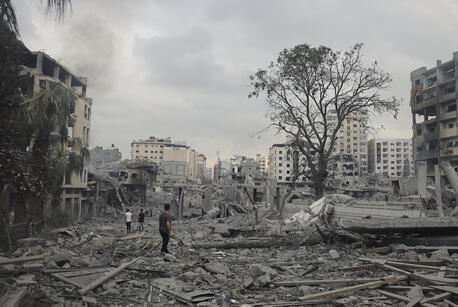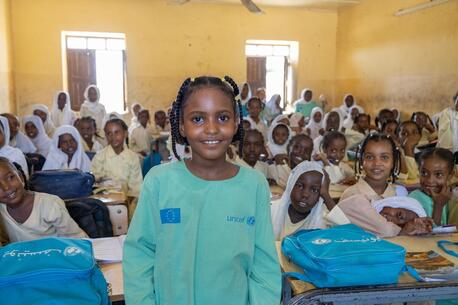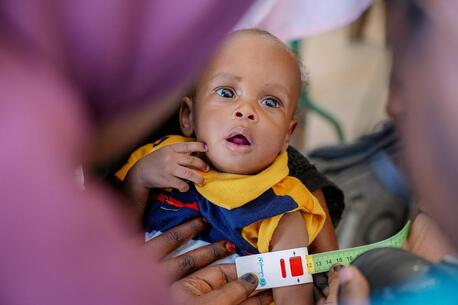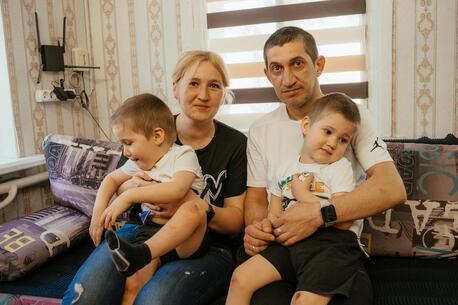
Firsthand Account: No Safety for Children in Gaza
UNICEF Spokesperson James Elder traveled 22 miles from Rafah to Gaza City with an aid convoy during the brief pause in fighting in November 2023. He writes about the devastation he saw and the absence of safe places for children and families.
A dystopic scene that seemed to stretch on endlessly
Last week, in the city of Khan Yunis, I met 11-year-old Omar and his Aunt Hamida. They were sheltering at the educational facility alongside tens of thousands of other civilians who had been displaced by the horrific violence inflicted on Gaza over the past two months.
Omar’s aunt told me quietly that a bomb had struck Omar’s home several days earlier, killing his mother, father and twin brother. During our conversation, Omar would pause and close his eyes for a few moments, with a look of deep concentration on his face. His aunt later explained to me that Omar was doing this to make sure he could remember the faces of his dead family members – faces he was deeply afraid he would forget.
Today, there are thousands of children like Omar across Gaza; children who have lost everything since the war started – their loved ones, their homes, their safety, and for over 110 a day, their lives.
That’s because inside Gaza, there is nowhere safe for children to go.
I’ve spent my 20-year career with UNICEF working in humanitarian crises around the world – from famines and floods to war zones and remote refugee camps. Yet none of these experiences prepared me for the level of devastation and despair that I witnessed in Gaza.
During the brief pause in fighting from Nov. 23 – 30, I accompanied a humanitarian aid convoy at Rafah and made the [22-mile] journey north to Gaza City, which hadn’t received aid in weeks. Along the way, I saw home after home flattened by the bombings – a dystopic scene that seemed to stretch on endlessly.
In Gaza City, I walked across the wreckage of what was once a bustling community, now just broken glass, rubble and steel crunching under my feet. I saw homes sliced open with no exterior walls, their contents exposed like doll houses. And I saw the eerie remnants of normal life, like a sofa on a third-floor apartment with no walls … or what was once a child’s bedroom with pink blankets, shelves full of books and fluffy stuffed toys, still there as if waiting for their return.
Later in Gaza City, I happened upon a man in his 60s walking out from a recently bombed apartment building that now looks like an amorphous mass of concrete. He used his fingers to tell me the number of family members killed in the building, and at first, I thought he was indicating the number ‘ten’. But he corrected me, using a stick to write ‘30’ in the dirt – 30 family members lost forever in the wreckage of that building. He told me he had lost everyone he loved, and that Gaza had become a graveyard for children and a living hell for those who survived.
From Gaza City we pushed further north to Jabalia, where we visited the Ahli Arabia hospital. It was a chaotic scene with humanitarian teams delivering medical supplies while wounded people were being rushed in. Children missing limbs or clinging to life. In the midst of that chaotic scene, some of the patients thought I was a doctor and came to me asking for help. In a week of despairing moments, this represented an absolute nadir. If only I were a doctor, I might have been more useful. I might have been able to provide them with the care that they so desperately needed. But we each have a role to play, and in this conflict, the best thing I can do is ensure the world knows what is happening in Gaza.
And what is happening now, since fighting has resumed, is the situation has gotten worse. Much worse.
Despite promises made that the horrors visited on the north of the territory would not be repeated, I saw firsthand how the south is now being pummeled. Children are being killed and brutally injured. Houses, schools and hospitals are being destroyed.
There is talk of creating safe zones for Gaza’s civilians to protect them from the intensifying violence in the south.
But the safe zones proposed for Gaza are unworkable and dangerous – mostly because there is no safety to be found. Safety means, by law, both safety from bombardments and sufficient resources for survival – water, food, sanitation and shelter. I have seen for myself that they are entirely absent. These so-called safe zones are indeed becoming zones of disease.
Genuine safety for Gaza’s children depends on parties to the conflict ensuring that humanitarians having unimpeded access to civilians wherever they are … on our ability to bring water, essential food, nutrition supplements, fuel and other humanitarian supplies into the territory … and on parties implementing an immediate humanitarian ceasefire.
Unless those conditions are met, children in Gaza are now in danger from the sky, disease on the ground, and death from hunger and thirst. Nowhere is safe.
The children of Gaza have suffered enough. We need a humanitarian ceasefire now.
Despite the dangerous situation, UNICEF continues to deliver lifesaving supplies, such as medicine and sanitation supplies as well as services such as access to clean water, education and mental health support to children and families in Gaza. Learn more about these response efforts.
Support UNICEF's mission responding to emergencies impacting children around the world. Donate today.
HOW TO HELP
There are many ways to make a difference
War, famine, poverty, natural disasters — threats to the world's children keep coming. But UNICEF won't stop working to keep children healthy and safe.
UNICEF works in over 190 countries and territories — more places than any other children's organization. UNICEF has the world's largest humanitarian warehouse and, when disaster strikes, can get supplies almost anywhere within 72 hours. Constantly innovating, always advocating for a better world for children, UNICEF works to ensure that every child can grow up healthy, educated, protected and respected.
Would you like to help give all children the opportunity to reach their full potential? There are many ways to get involved.





